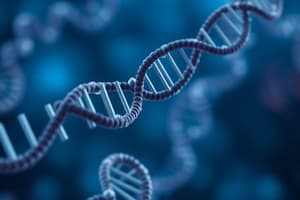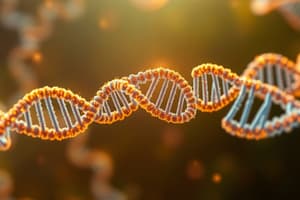Podcast
Questions and Answers
What is the primary function of RNA transcription in gene expression?
What is the primary function of RNA transcription in gene expression?
- To translate RNA sequences into amino acid sequences
- To convert DNA sequences into RNA molecules (correct)
- To synthesize proteins directly from DNA
- To regulate gene expression by binding to specific DNA sequences
What is the role of transcription factors in gene expression?
What is the role of transcription factors in gene expression?
- To regulate gene expression by interacting with RNA polymerase (correct)
- To convert DNA sequences into RNA molecules
- To synthesize proteins directly from DNA
- To translate RNA sequences into amino acid sequences
What is the main difference between DNA transcription and RNA transcription?
What is the main difference between DNA transcription and RNA transcription?
- DNA transcription occurs in the nucleus, while RNA transcription occurs in the cytoplasm
- DNA transcription is a direct process, while RNA transcription involves an intermediate step (correct)
- DNA transcription involves the synthesis of RNA, while RNA transcription involves the synthesis of DNA
- DNA transcription is regulated by transcription factors, while RNA transcription is not
What is the function of the coding region in messenger RNA (mRNA)?
What is the function of the coding region in messenger RNA (mRNA)?
What is the universal set of rules that dictates how nucleotide sequences are translated into amino acid sequences?
What is the universal set of rules that dictates how nucleotide sequences are translated into amino acid sequences?
What is the role of untranslated regions (UTRs) in messenger RNA (mRNA)?
What is the role of untranslated regions (UTRs) in messenger RNA (mRNA)?
What is the process by which information from a gene is converted into a functional product?
What is the process by which information from a gene is converted into a functional product?
What is the function of RNA polymerase in RNA transcription?
What is the function of RNA polymerase in RNA transcription?
What is the result of a point mutation in the DNA sequence?
What is the result of a point mutation in the DNA sequence?
What is the function of tRNA adapter molecules in protein synthesis?
What is the function of tRNA adapter molecules in protein synthesis?
Flashcards are hidden until you start studying
Study Notes
Transcription
RNA Transcription
- Process by which DNA sequence is copied into RNA molecule
- Occurs in three stages: initiation, elongation, and termination
- Involved in gene expression, allowing cells to synthesize proteins
DNA Transcription
- Not a direct process; DNA is transcribed into RNA, which is then translated into protein
- DNA serves as a template for RNA synthesis
Messenger RNA (mRNA)
- Type of RNA that carries genetic information from DNA to ribosome
- Acts as a template for protein synthesis
- Three main regions: untranslated regions (UTRs), coding region, and poly-A tail
Gene Expression
- Process by which information from a gene is converted into a functional product (protein)
- Involves transcription and translation of genetic code
- Regulated by transcription factors, which bind to specific DNA sequences
Transcription Factors
- Proteins that bind to specific DNA sequences to regulate gene expression
- Can activate or repress transcription by interacting with RNA polymerase
- Play crucial role in development, cell growth, and response to environmental stimuli
Genetic Code
- Set of rules that dictates how nucleotide sequences are translated into amino acid sequences
- Consists of 64 possible codons, each specifying one of 20 amino acids or a stop signal
- Universal among all living organisms
Mutations
- Changes in DNA sequence that can affect gene expression and protein function
- Can be point mutations (single nucleotide change) or frameshift mutations (insertion or deletion of nucleotides)
- Can result in changes to protein function, leading to disease or disorder
tRNA Adapter Molecule
- Type of RNA that brings amino acids to ribosome during protein synthesis
- Has a specific sequence that binds to mRNA codon and a binding site for amino acid
- Ensures correct amino acid is incorporated into protein sequence
RNA Transcription
- RNA transcription is a three-stage process: initiation, elongation, and termination, which copies a DNA sequence into an RNA molecule.
- This process is crucial for gene expression, enabling cells to synthesize proteins.
DNA Role in Transcription
- DNA serves as a template for RNA synthesis, but it is not directly translated into protein.
- Instead, DNA is transcribed into RNA, which is then translated into protein.
Messenger RNA (mRNA)
- mRNA carries genetic information from DNA to the ribosome and acts as a template for protein synthesis.
- mRNA consists of three main regions: untranslated regions (UTRs), coding region, and poly-A tail.
Gene Expression
- Gene expression is the process by which information from a gene is converted into a functional product (protein).
- It involves the transcription and translation of the genetic code.
- Gene expression is regulated by transcription factors, which bind to specific DNA sequences.
Transcription Factors
- Transcription factors are proteins that bind to specific DNA sequences to regulate gene expression.
- They can activate or repress transcription by interacting with RNA polymerase.
- Transcription factors play a crucial role in development, cell growth, and response to environmental stimuli.
Genetic Code
- The genetic code is a set of rules that dictates how nucleotide sequences are translated into amino acid sequences.
- The code consists of 64 possible codons, each specifying one of 20 amino acids or a stop signal.
- The genetic code is universal among all living organisms.
Mutations
- Mutations are changes in the DNA sequence that can affect gene expression and protein function.
- Types of mutations include point mutations (single nucleotide change) and frameshift mutations (insertion or deletion of nucleotides).
- Mutations can result in changes to protein function, leading to disease or disorder.
Transfer RNA (tRNA)
- tRNA is a type of RNA that brings amino acids to the ribosome during protein synthesis.
- tRNA has a specific sequence that binds to the mRNA codon and a binding site for an amino acid.
- tRNA ensures the correct amino acid is incorporated into the protein sequence.
Studying That Suits You
Use AI to generate personalized quizzes and flashcards to suit your learning preferences.




